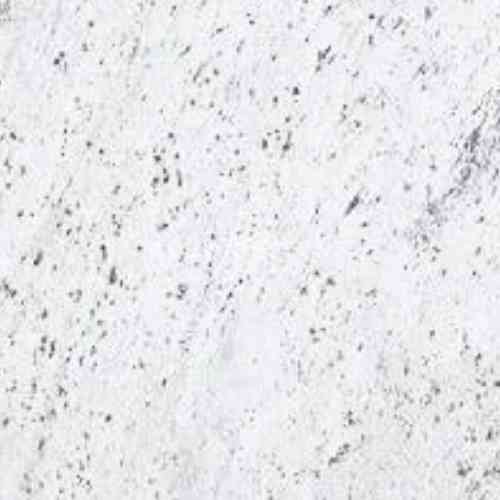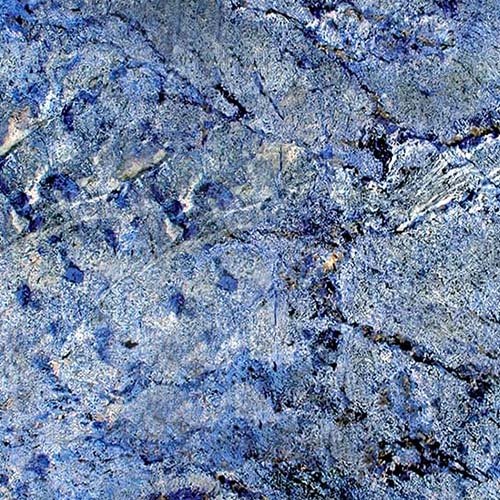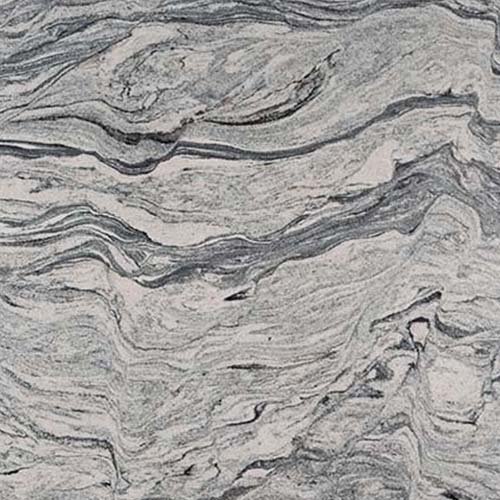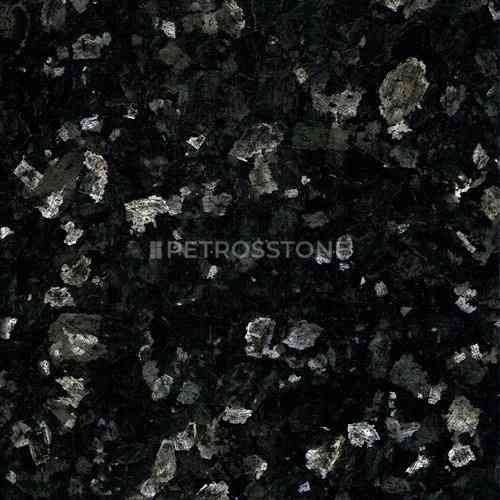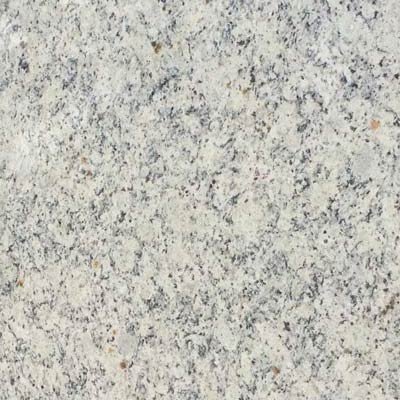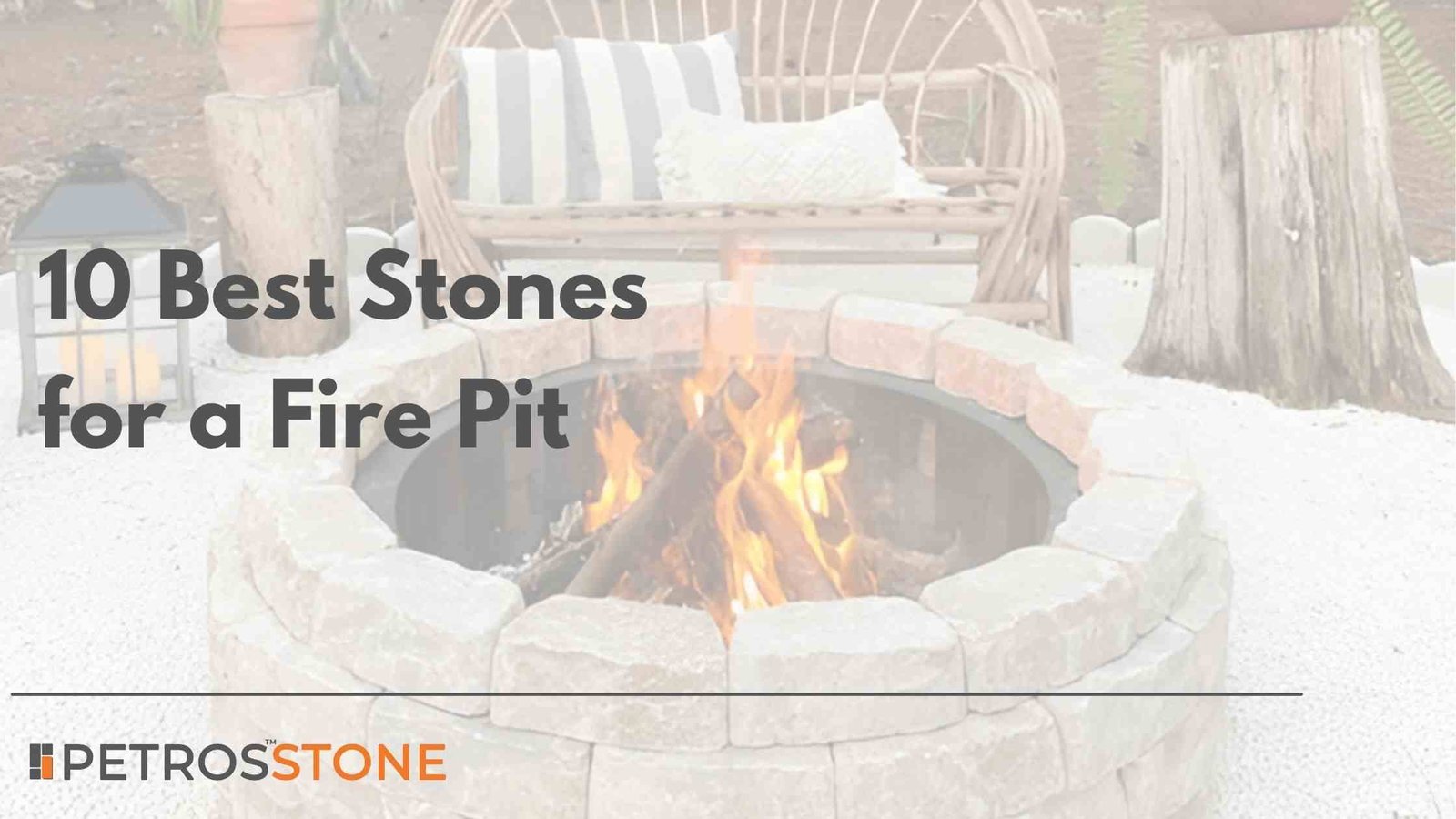
A fire pit brings warmth to the center of a yard. It shares good times with family and friends on a chilly evening. A quality fire pit is safe, durable, and will endure for many years and become a real nice addition to the landscape. The stone you choose is more important than most people realize. The wrong rock will crack, break, or even shatter when it gets hot. The right stone retains heat, withstands the elements, and matches your taste for the outdoors.
The basic stone prices may range from USD 3 – 30+ per sq. ft., while stone veneer runs USD 6 – 50 per sq. ft. Refractory bricks can cost USD 50 – 400+ per set, and installation labor ranges from USD 200 – 2,000+. Overall, a simple pit project can total anywhere from USD 300 for a DIY build to over USD 6,000 for premium, professional work.
In this article, we explain how to choose the best stones for your fire pit. We cover the key things to consider first, and then provide details about the 10 best stones to be used for building the pit body. Options such as gravel, crushed stone, and decorative rock that complement the fire pit have also been discussed. You will find inspiration for design, safety precautions, care instructions, and overall budgetary considerations.
- Key Factors to Consider When Choosing Fire Pit Stones
- Best Natural Stones for Fire Pit Construction
- Granite
- Sandstone
- Limestone
- Bluestone
- Slate
- Basalt
- Quartzite
- Soapstone
- Refractory Fire Bricks (engineered)
- Concrete Blocks with Stone Veneer (engineered)
- Best Gravel, Crushed Stone, and Rock for Fire Pit Surroundings
- Fire Pit Design Ideas Using Stone
- Stone Safety Tips for Fire Pits
- Stone Maintenance and Care
- Cost, Sourcing, and Installation Tips
- Summary
- Key Takeaways
Key Factors to Consider When Choosing Fire Pit Stones
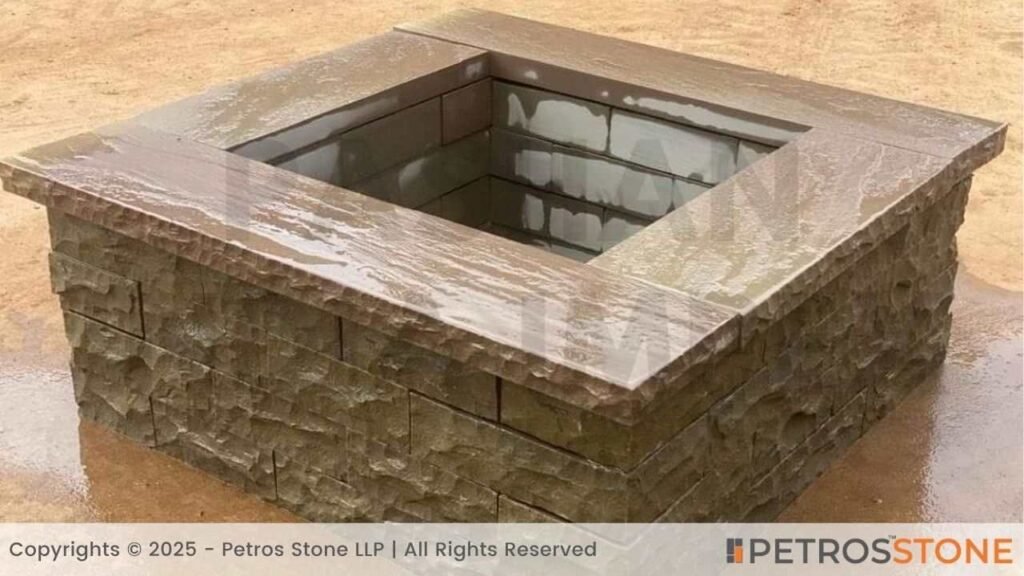
Deciding the right stone for a fire pit is not just about choosing something that’s beautiful. The stone must be durable under heat, to weather outdoors, and meet your design style and budget.
Heat Resistance and Thermal Expansion
- Fire pits generate high, cyclical heating and cooling.
- Stones with low thermal expansion are less likely to be busted.
- Steer clear of stones that absorb water rapidly, on the other hand, as they accumulate moisture can explode when heated.
- Heavy stones like granite, basalt, and firebrick work best near fire.
Structural Durability in Outdoor Environments
- Outdoor stones endure rain, frost, wind, and sun all year round.
- Freeze–thaw cycles can ruin softer or more porous stones.
- Select stones that are not prone to erosion and surface flaking.
Maintenance and Cleaning Needs
- You can clean some stones with a stiff brush and water.
- Porous stones are susceptible to staining from soot or ash and require sealing.
- Think about how you would be willing to clean out the fire pit on a regular basis.
Visual Aesthetics and Outdoor Theme Compatibility
- The color and texture of stone contribute to the atmosphere in your area.
- Warm, earthy colors (sandstone or limestone) are homey and rustic.
- Smooth, blackish stones (slate or basalt) give a contemporary or minimalist style.
Cost-Effectiveness and Availability
- Stones found locally are usually cheaper.
- Expensive or uncommon stones add to the budget yet can have unusual appearances.
- Get the optimal combination of endurance, aesthetics, and cost.
Table: Comparison of Stone Selection Factors for Fire Pits
| Factor | Why It Matters | Best Stone Choices | Common Mistakes to Avoid |
| Heat Resistance | Prevents cracking or exploding under high temperatures. | Granite, Basalt, Fire Bricks | Using porous river rocks or wet stones directly in the fire area. |
| Outdoor Durability | Ensures the stone withstands rain, frost, and UV exposure. | Quartzite, Bluestone, Slate | Choosing soft stones that break down in freeze–thaw cycles. |
| Ease of Cleaning | Keeps the fire pit looking neat and prevents long-term staining. | Polished Granite, Sealed Sandstone | Leaving soot or ash buildup for long periods. |
| Aesthetic Match | Creates a cohesive look with the patio, furniture, and landscaping. | Sandstone for rustic, Basalt for modern | Mixing too many stone colors or textures without a theme. |
| Affordability & Availability | Controls project cost while ensuring quality materials. | Locally sourced Granite or Limestone | Overpaying for imported stones when local options are equally strong. |
Quick checklist before buying
- Is the stone dense and non-porous?
- Does it sustain direct heat, or should it be supported by fire bricks?
- Does the color and texture work in your area?
- Do you have access to the stone at an affordable price?
Best Natural Stones for Fire Pit Construction
Here are ten powerful options for constructing the body of the fire pit. The best features and what to look for in each stone have been highlighted here.
Granite
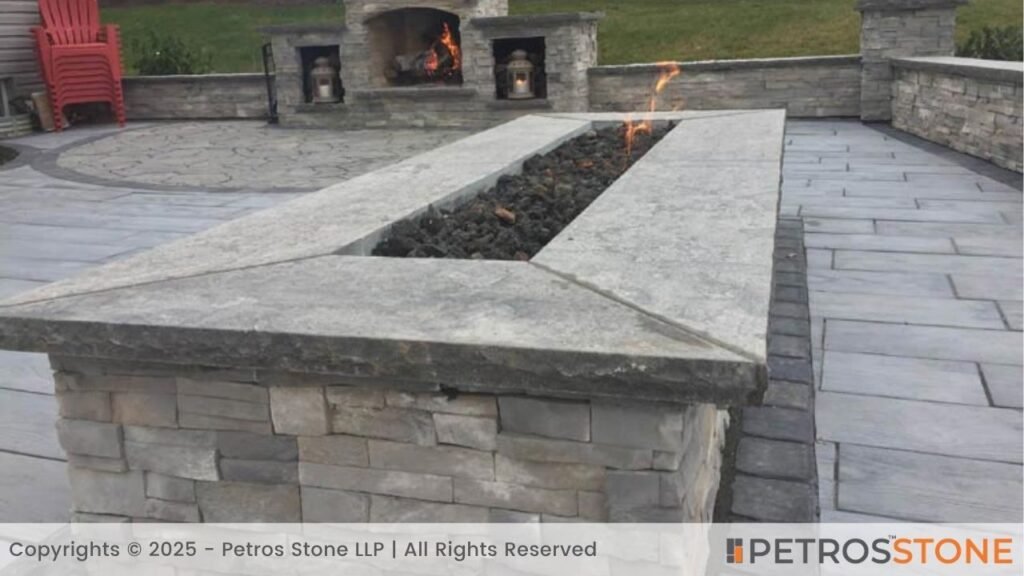
Granite is a very dense rock that is igneous. It tolerates heat and weather. It is available in numerous colors and patterns. Granite is dense and may be more difficult to work. It can be used in formal or rustic schemes.
Sandstone
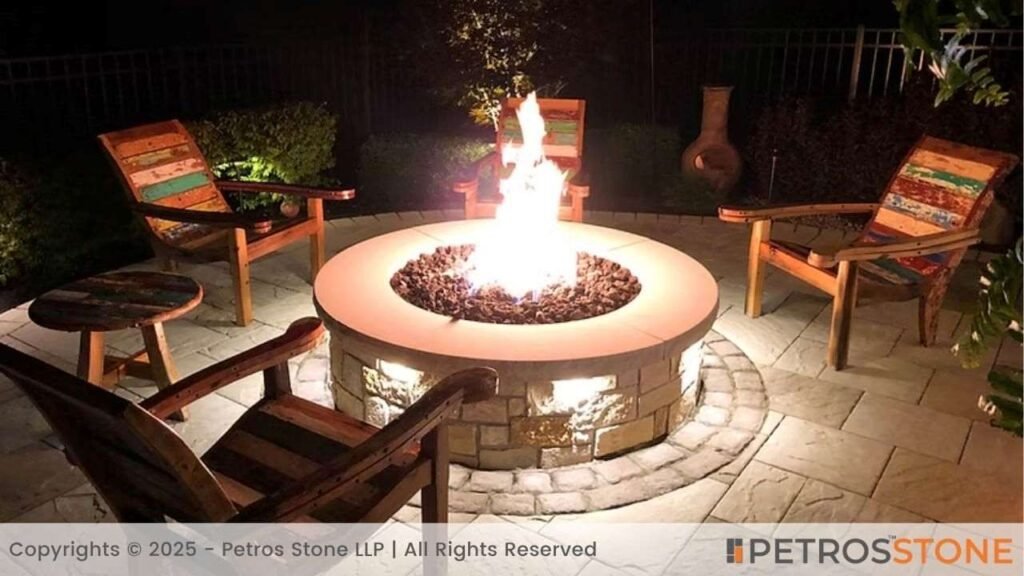
Sandstone is warm-toned and grained. It is more easily moulded and produces a natural, casual appearance. Other sandstone types are soft; dense sandstone is better to avoid flaking.
Limestone
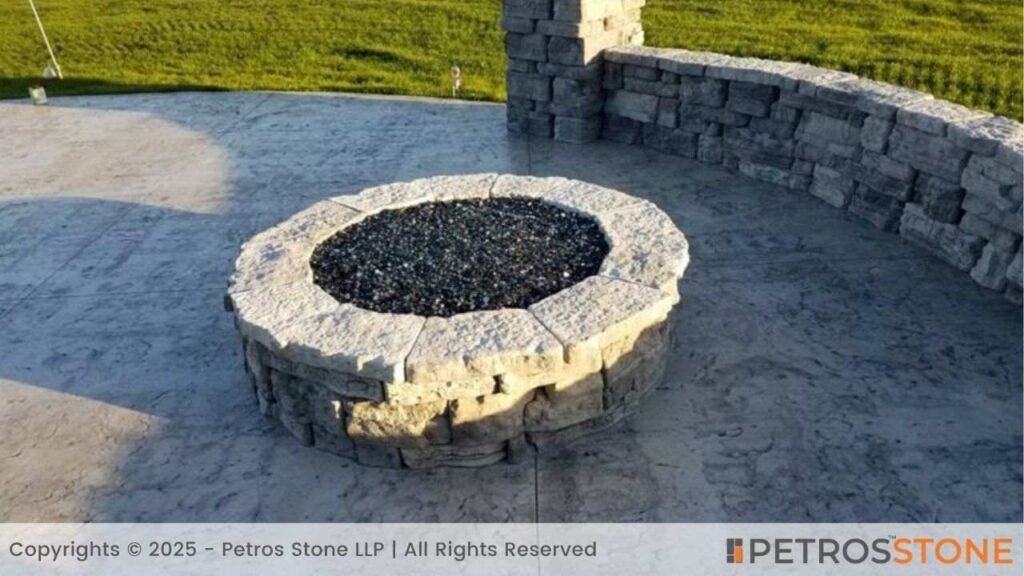
Limestone tends to be light in color and is easy to carve. It ages well and is good in Mediterranean or farmhouse designs. Do not use very soft limestone, which is subject to erosion in moist environments.
Bluestone
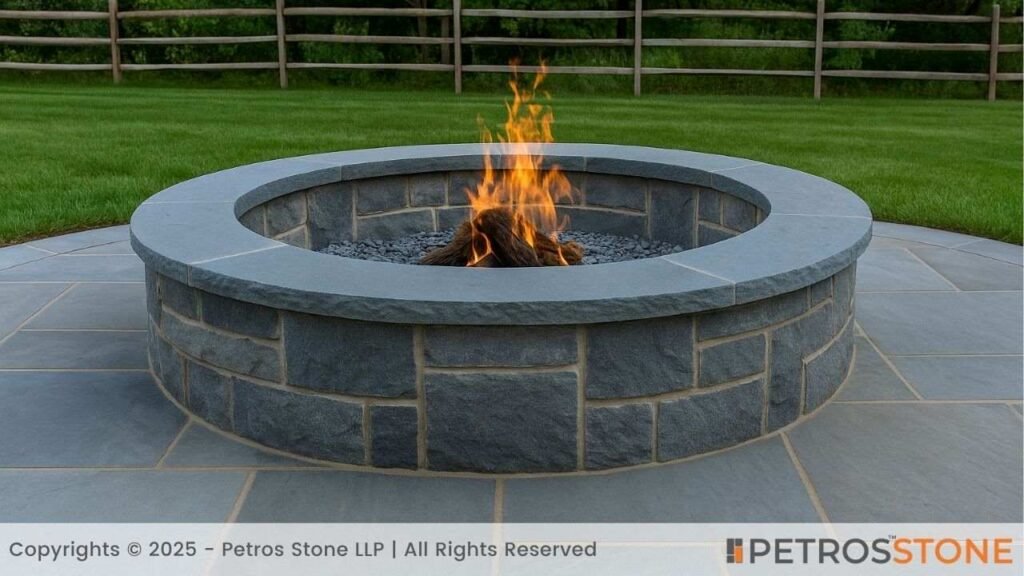
Bluestone (Dense sandstone or flagstone) – has a smooth/flat appearance and a cool blue-gray color. It is robust and offers a modern, tidy appearance. It can be more costly and heavier.
Slate
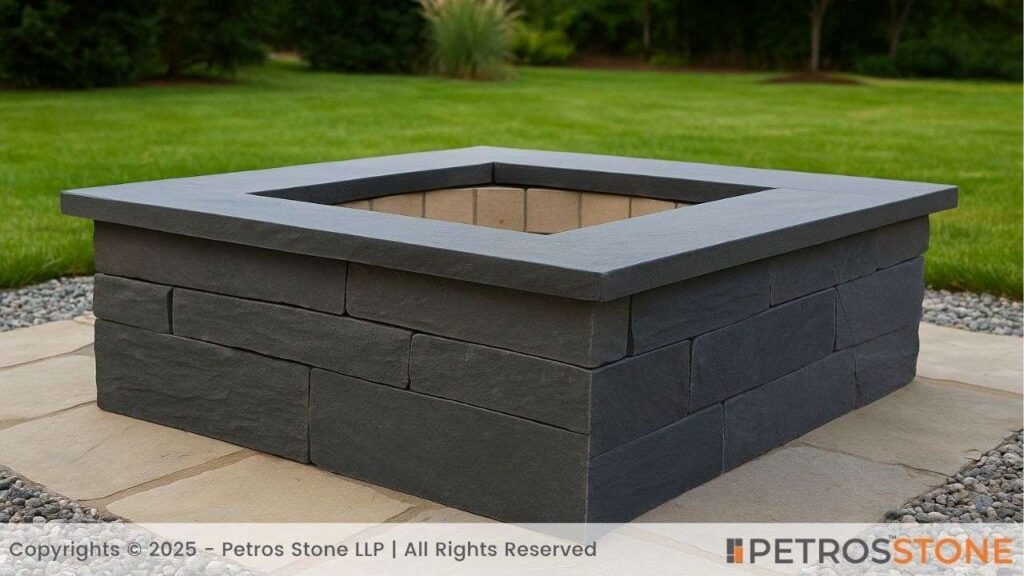
Slate is also fine-grained, split into flat sheets. It is not heat sensitive, and its appearance is clean and modern. Slate is susceptible to delaminating when subjected to heavy impacts; be careful during the construction.
Basalt
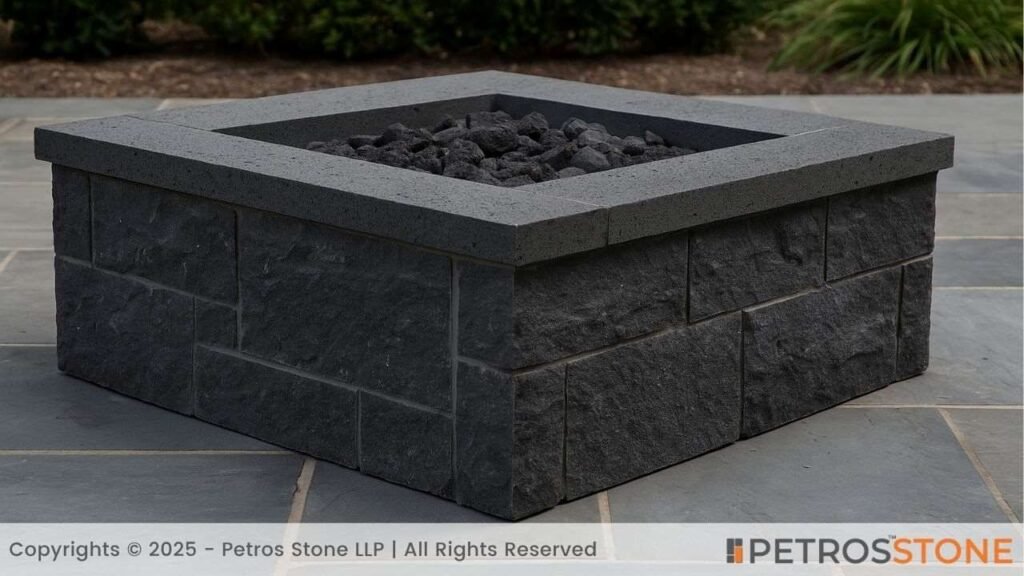
Basalt is a heavy, volcanic, black rock. It is highly resistant to heating and appears daring and trendy. It is best suited to dramatic, modern fire pits.
Quartzite

Quartzite is a product of quartz that has undergone heat and pressure within sandstone. It is dense, compact, and cannot be stained easily. Quartzite also offers desirable veining, and it handles nicely in high-end rustic or contemporary design.
Soapstone
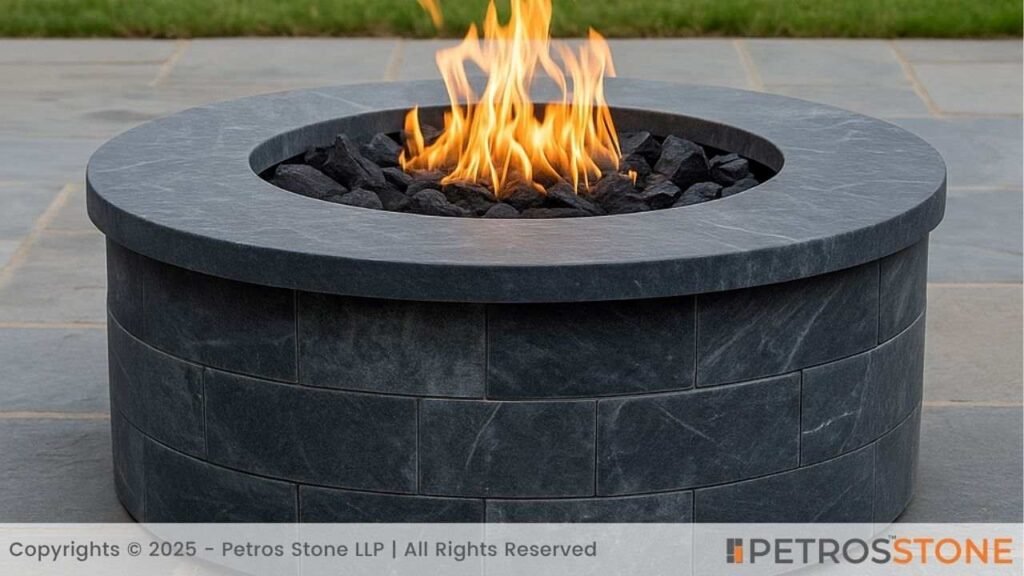
Soapstone is soft and retains heat. It warms gradually and lingers long after a fire cools. Owing to its high thermal stability, it has low cracking rates. It may be more expensive and scarcer.
Refractory Fire Bricks (engineered)
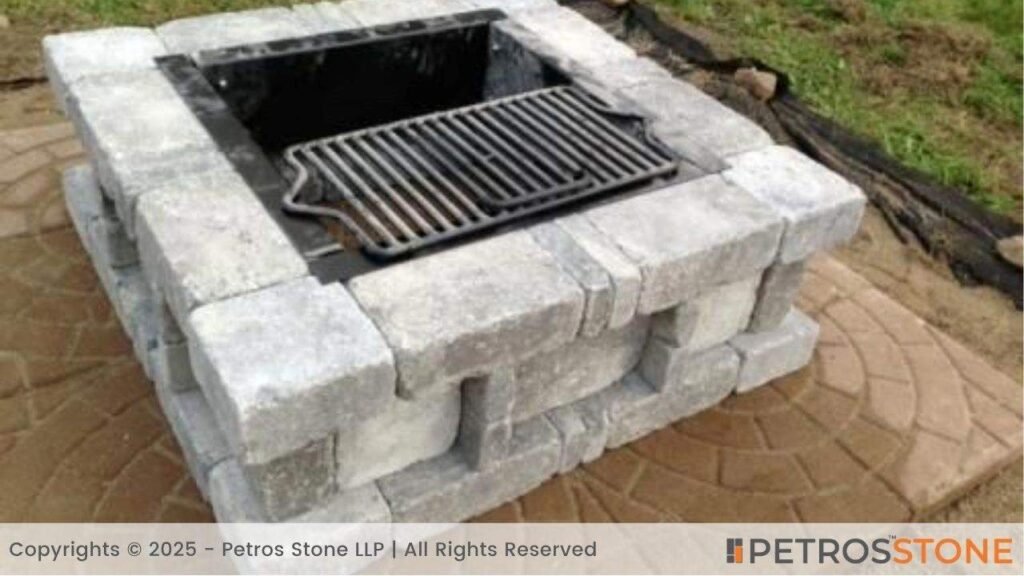
It is not a natural stone but a fire brick. Place them in the pit as a shield around the outer stones. They can endure harsh temperatures and protect the shell from outside breakage.
Concrete Blocks with Stone Veneer (engineered)
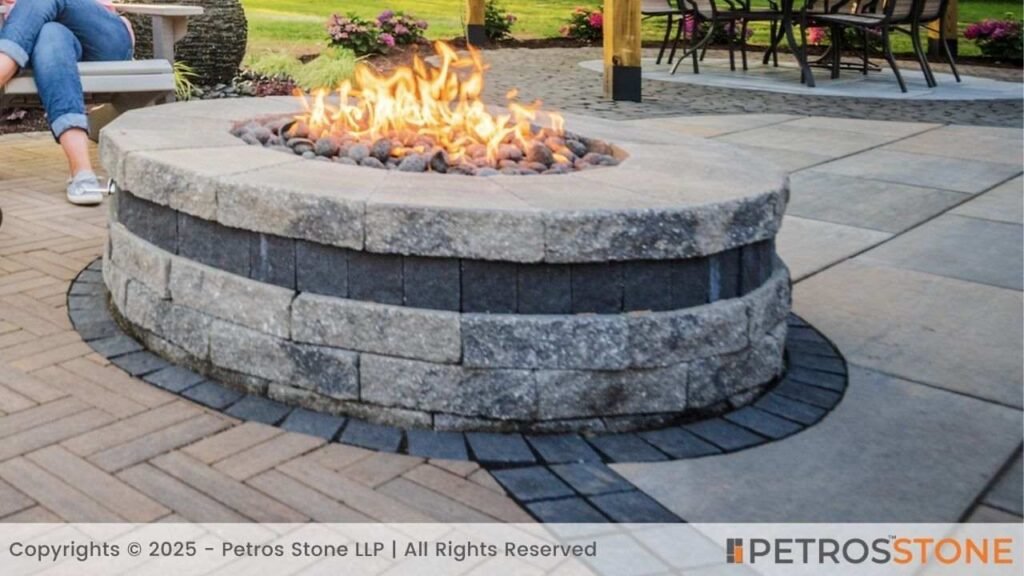
Concrete blocks give low-cost but powerful construction. It has the appearance of real stone at a reduced price because of its thin stone veneer. Enclose that in fire bricks, or use a steel ring, so that the concrete is not exposed to the direct flame.
Table: Quick Comparison of the Top 10 Fire Pit Stones
| Material | Heat Resistance | Outdoor Durability | Maintenance | Typical Cost | Best For |
| Granite | High | High | Low | Mid | Long-lasting, versatile |
| Sandstone | Moderate-High | Moderate | Low | Low to Mid | Rustic, natural look |
| Limestone | Moderate | Moderate | Moderate | Mid | Light aesthetic, classical |
| Bluestone | High | High | Low | High | Sleek, modern patios |
| Slate | High | High | Low | Mid | Flat, minimalist design |
| Basalt | Very High | Very High | Low | High | Dramatic, contemporary |
| Quartzite | Very High | Very High | Low | Mid–High | Upscale rustic/modern |
| Soapstone | Very High | High | Low | High | Heat-retaining, cozy |
| Refractory Fire Bricks (engineered) | Very High | Very High | Very Low | Low | Inner lining (safety) |
| Concrete + Stone Veneer (engineered) | Moderate* | High | Moderate | Low | Budget-friendly, flexible |
*Requires proper liner or fire bricks for direct heat.
Best Gravel, Crushed Stone, and Rock for Fire Pit Surroundings
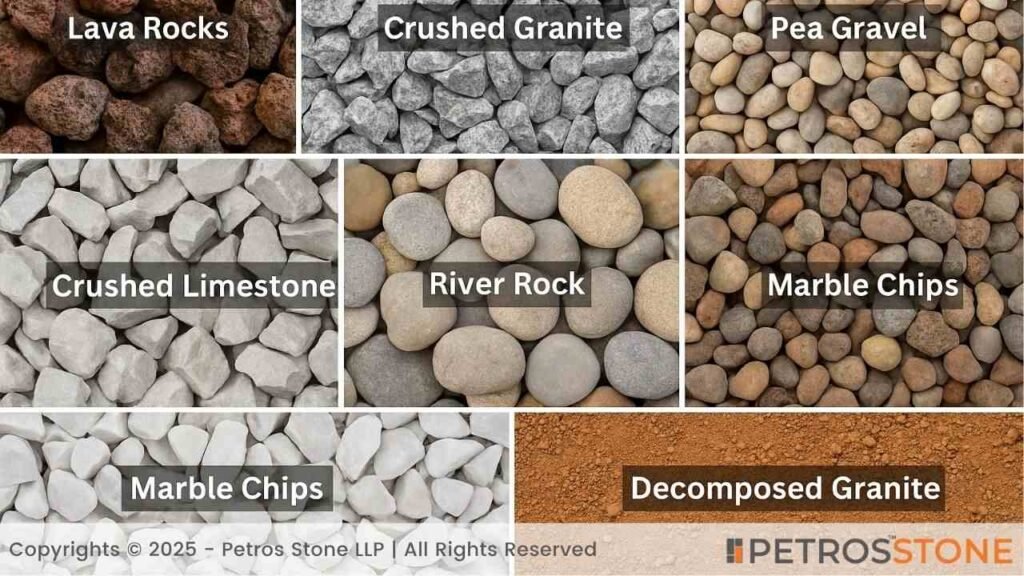
The proper base and surround material aids drainage, lessens sparks, and completes the structure. These are powerful options, and when to employ them.
Lava Rocks
- Honeycomb volcanic rocks.
- Light and heat-resistant.
- Useful both for lining in the pit and decoration.
- Ash and drains well.
Crushed Granite
- Angular and compacts well.
- Suitable for steady footpaths and seats.
- Drains freely and is difficult to move.
Pea Gravel
- Pebbles, stuffed and little.
- Easy to rake and comfortable to walk on.
- Performs adequately in the immediate surroundings but not directly in contact with open fires.
Crushed Limestone
- Sharp, bright rocks.
- Good to contrast with darker pit stone.
- Compacts firmly, yet may absorb a little moisture, not exposed to direct flame.
River Rock (Use with caution)
- Rounded and ornamental.
- Able to entrap water; when warmed, it might crack or pop.
- Hold at least one foot above hot edges.
Marble Chips
- Metallic, luxurious appearance.
- Most applicable to the outer edge with moderate heat.
- It is potentially slippery when wet.
Decomposed Granite (DG)
- Sandy granite that packs to a firm surface.
- Path and large parties about the pit.
- Not in direct contact with flames.
Table: Gravel & Rock Options at a Glance
| Material | Drainage | Heat Safe Next to Flame | Comfort Underfoot | Typical Use |
| Lava Rocks | Excellent | Yes | Medium | Inside base or decorative |
| Crushed Granite | Excellent | No (keep slightly back) | Medium-High | Paths, seating areas |
| Pea Gravel | Very Good | No (near flame caution) | High | Surround zone, casual seating |
| Crushed Limestone | Good | No | Medium | Outer border, patio |
| River Rock | Moderate | No (keep away) | Medium | Decorative border only |
| Marble Chips | Good | No | Low | Outer decorative border |
| Decomposed Granite | Good | No | High | Paths and compacted patios |
Fire Pit Design Ideas Using Stone
A stone fire pit can be constructed in several ways. Five of these designs follow below with abridged build notes and ideal stone selections.
Circular Stacked Stone Fire Pit
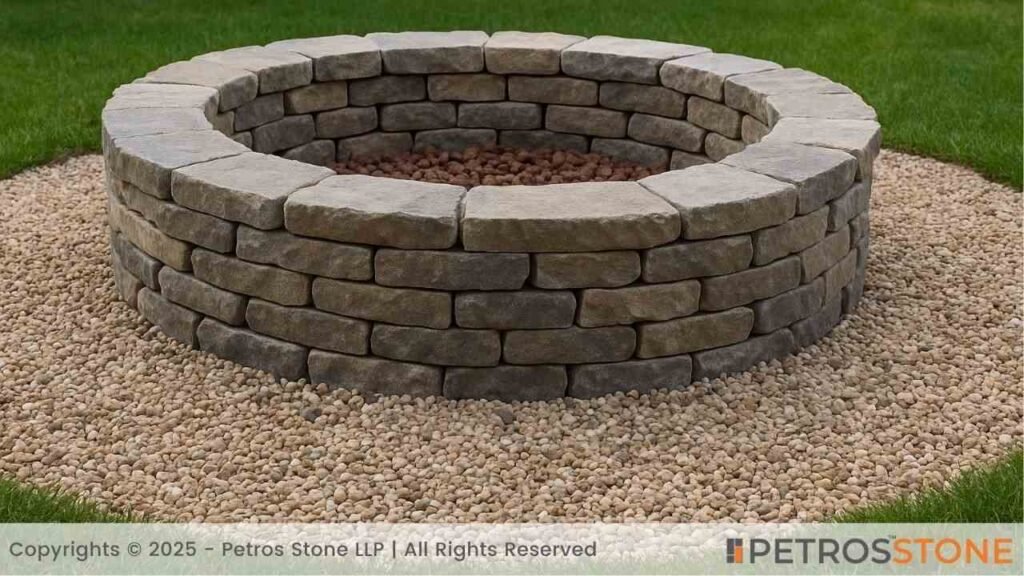
- Constructed of dry-stacked granite or sandstone, 8 to 12 courses.
- Cover the inside with fire bricks.
- Border with a 2 to 3-foot strip of pea gravel to bound it out.
Square Granite and Steel Fire Pit
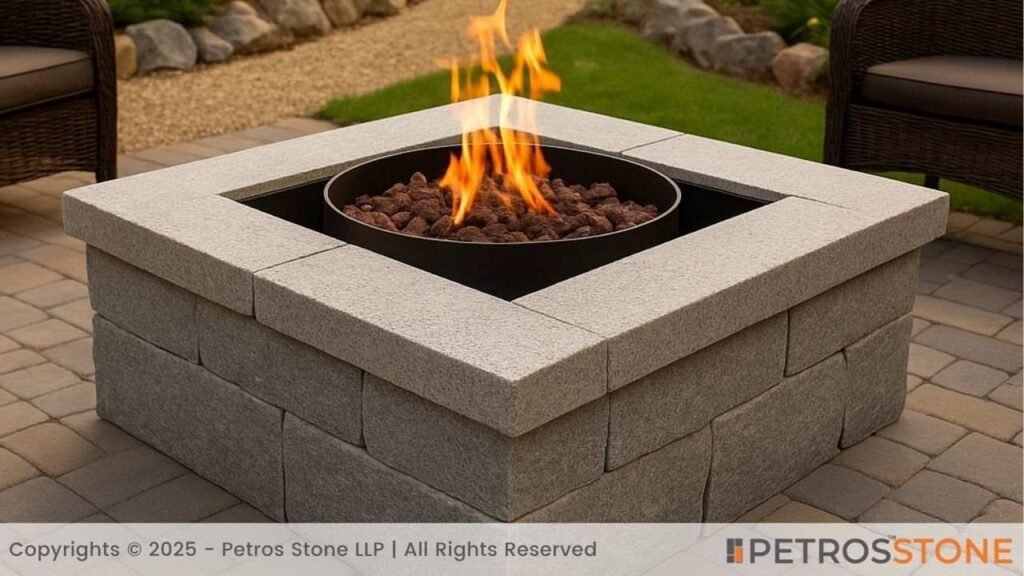
- Use granite slabs or blocks to create a crisp square.
- Add a steel fire ring insert.
- Granite cap to finish cleanly.
Sunken Fire Pit with Gravel Surround
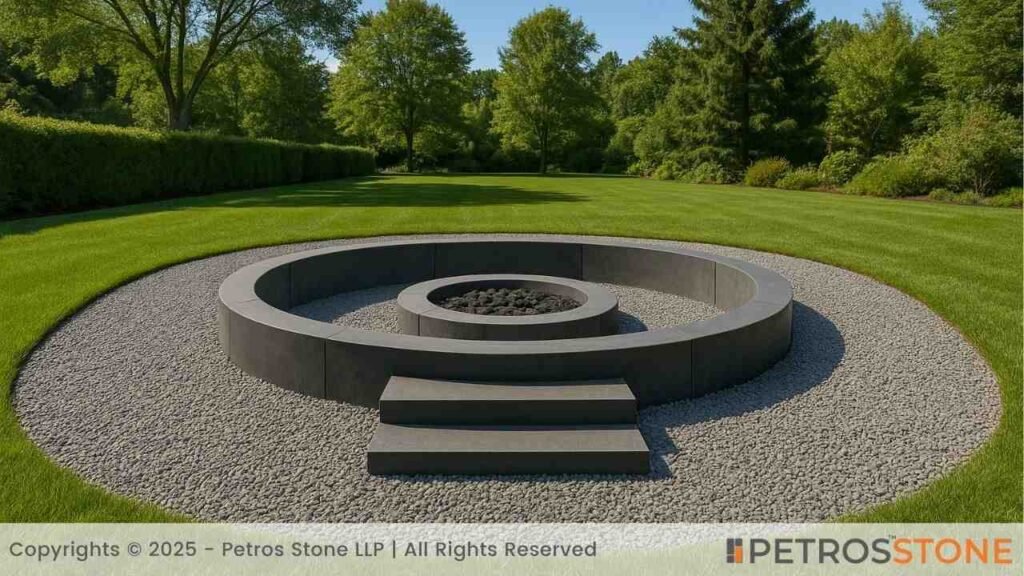
- Make a shallow pit, and construct in bluestone or limestone.
- Build a low-sitting wall.
- Smooth access via decomposed granite/crushed granite paths.
Mixed-material Fire Pit (Stone, Veneer, and Crushed Rock)
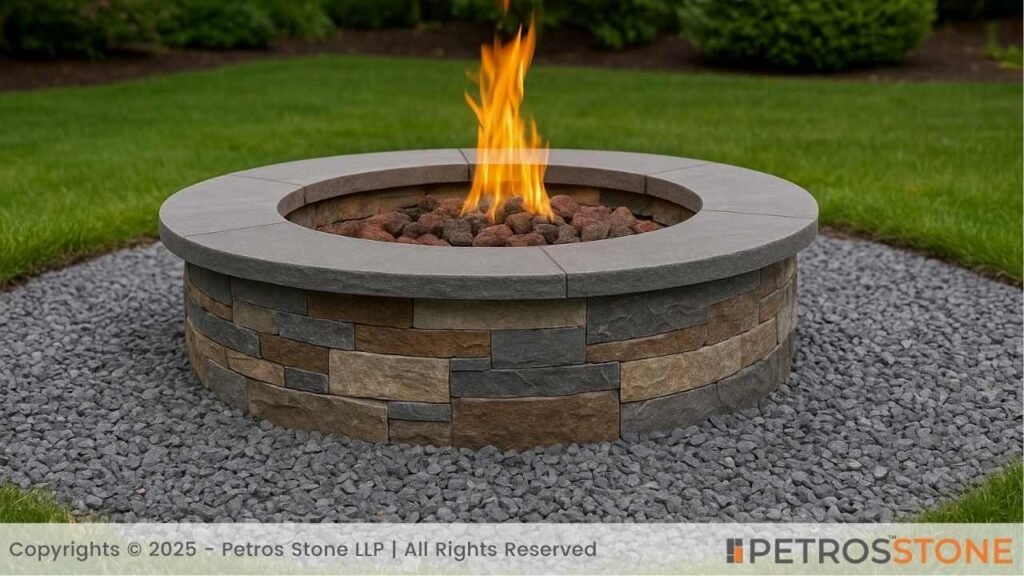
- Construct a concrete block main body, and insert refractory bricks.
- Board the exterior with slate veneer or quartzite.
- A base of crushed limestone or lava rock.
Rustic Fieldstone Fire Ring with Lava Rock Interior

- Use irregular fieldstones (sandstone or granite) in stacks to form an organic edge.
- Fire-brick line and a layer of lava rocks.
- Use a natural frame by planting native grass a few feet away.
Table: Design Summary with Best Materials
| Design Type | Main Stones | Liner or Base | Best For |
| Circular stacked stone | Granite, Sandstone | Fire bricks + lava rock | Casual gatherings |
| Square granite + steel | Granite slabs | Steel ring + gravel | Modern patios |
| Sunken fire pit | Bluestone, Limestone | Lava rock + DG | Low-profile backyard |
| Mixed-material (veneer) | Quartzite, Slate veneer | Fire bricks + crushed stone | Budget + style balance |
| Rustic fieldstone ring | Fieldstone (Sandstone) | Fire bricks + lava rock | Country or cottage style |
Stone Safety Tips for Fire Pits
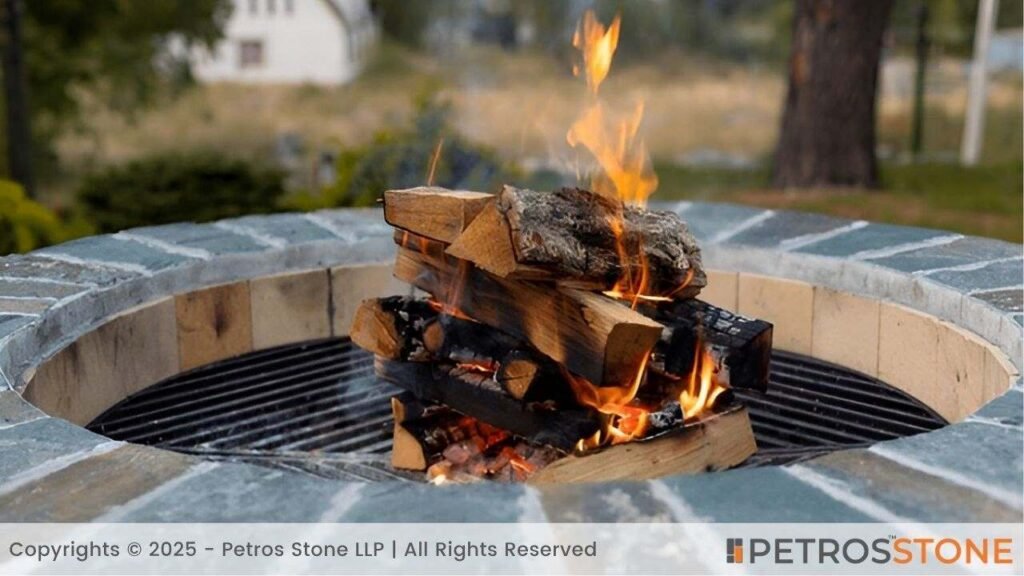
The safety makes parties entertaining and damage-free. Adhere to these main rules.
Avoid using porous or water-absorbing stones near flames
- Water may be stored in porous stones. Heated trapped water transforms to steam, which can crack or explode the stone.
Always install a metal or fire-rated liner inside the pit
- The outer stone is guarded by a steel fire ring or fire bricks to hold the fire.
Use fire-rated gravel (like lava rocks) in the base
- These materials enhance drainage, minimize steam hazards, as well as simplify cleanup.
Maintain safe distances from flammable landscaping materials
- The mulch, plants, and wooden furniture should be at least 3-5 feet away from the pit edge.
Ensure drainage to prevent steam pressure build-up
- Insert a small hole to drain or a layer of gravel to avoid water pooling under the rocks.
Table: Safety Tips Summary
| Tip | Action Required | Why It Matters |
| Avoid porous stones near a flame | Choose dense stone and a test sample | Prevents cracking/explosion |
| Install a metal or fire-brick liner | Fit the ring or bricks before the stone | Protects the outer shell |
| Use lava rocks or fire-safe gravel | Place 2–4 inches at the base | Improves drainage, ash control |
| Keep flammables away | Clear 3–5 feet around the pit | Reduces spread risk |
| Provide drainage | Add gravel or drain holes | Prevents steam pressure |
Stone Maintenance and Care

Proper maintenance prolongs the life and appearance of your stone fire pit. There are two useful subheadings with immediate, plain steps you can use as shown below.
Routine cleaning (weekly or after use)
- Sweep away ashes and big debris: Use a scoop or small shovel after coals become cool.
- Scrub rough soot: Scrub the capstones and interior walls with a stiff brush.
- Rinse lightly: In order to remove dust and residual ash, do not apply heavy pressure on the soft stone.
- Air dry between fires: Allow stones to dry completely or take a cloth in between fires.
- Keep an eye on chips or fine cracks: These scratches can be corrected earlier so as to address bigger fix-ups.
Seasonal and long-term care (monthly or yearly)
- An annual severe clean: Streak clean with minor soap and soft brush against diminishing markings. Rinse well.
- Inspect mortar and seams: Fill up any loose or crumbling mortar and veneer.
- Re-point when necessary: Add new mortar where needed to maintain stability.
- Seal stones when necessary: Certain stones buy a speedy look with a breathable sealant. Test a smaller region initially.
- Store loose material: Lava rocks or decorative gravel can be stored in wet seasons to cut down on debris accumulation.
Table: Maintenance Tools & Time Guide
| Task | Tools Needed | Frequency | Approx Time |
| Ash removal | Small shovel, bucket | After each use | 5–15 min |
| Brushing walls | Stiff brush | Weekly after use | 10–20 min |
| Light rinse | Garden hose | Weekly | 5–10 min |
| Deep clean | Mild detergent, scrub brush | Annually | 30–60 min |
| Mortar inspection or repair | Trowel, mortar mix | Yearly | 1–3 hours |
| Sealer reapply (if used) | Stone sealer, brush/roller | Every 2–3 years | 1–2 hours |
Cost, Sourcing, and Installation Tips
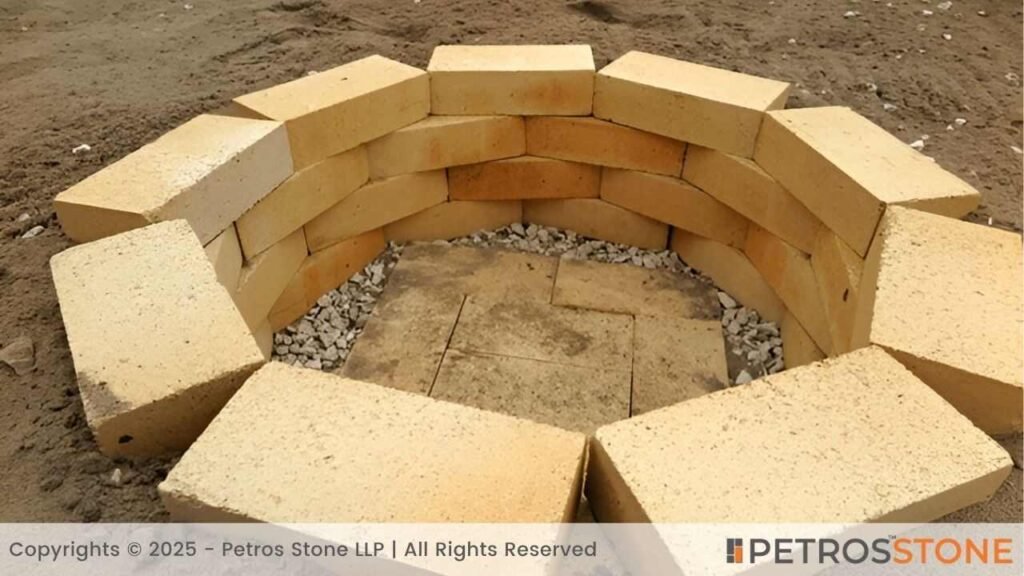
By thinking ahead and sourcing materials, money can be saved, and delays can be prevented.
Budget planning and cost-saving tips
- A definite budget: Set the cost of stone, liner, gravel, mortar, equipment, and labour.
- Safety comes first: Spend first on an adequate liner or fire bricks, then on fancy veneer.
- Use local stone whenever feasible: Local materials reduce transportation expenses.
- Mix materials: To save on costs, use concrete blocks indoors and some thin stone veneer on exteriors.
- Order a bit more than necessary: Order 5 – 10% overage on cuts and breakage.
- Rent equipment: Short-term construction, i.e., one-time: Rent a saw or compactor rather than purchase.
Finding materials and contractors
- Visit local masonry yards and quarries: They usually have old pieces and cheaper prices.
- Viewing showrooms: Try out full-scale samples to gauge colors and texture in natural daylight.
- Request contractor referrals: Masons who construct fire pits can give recommendations on types of stones as well as lining options.
- Find several price estimates: Ask 2-3 contractors to compare the price and the schedule.
- Ask to see references and photos: to see past work and evaluate quality.
- Take a DIY kit: Did you know there are complete kits that come with liner + veneer, recommended for beginners!
Table: Typical Cost Ranges (very approximate)
| Item | Low Cost (DIY) | Mid Cost (Pro) | High Cost (Premium) |
| Basic stone (per sq. ft.) | USD 3 – USD 8 | USD 8 – USD 15 | USD 15 – USD 30+ |
| Refractory bricks (set) | USD 50 – USD 200 | USD 200 – USD 400 | USD 400+ |
| Stone veneer (per sq. ft.) | USD 6 – USD 12 | USD 12 – USD 25 | USD 25 – USD 50 |
| Installation labor (pit) | USD 200 – USD 800 | USD 800 – USD 2,000 | USD 2,000+ |
| Gravel/base materials | USD 50 – USD 300 | USD 300 – USD 700 | USD 700+ |
| Total simple pit (materials) | USD 300 – USD 800 | USD 800 – USD 2,500 | USD 2,500 – USD 6,000+ |
Note: Prices differ drastically by area and source. These are rough limits to aid planning, not promises.
Summary
Building a fire pit with the correct kind of stone is not simply a question of the style but also of safety, durability, and building a place that will be a long-lasting hangout place with friends and family.
The stones selected should be those that can withstand intense heat, are not prone to cracking, and are capable of fitting in your outdoor design ideas. Natural rocks such as Granite, basalt, and quartzite can be ideal in terms of durability, whereas gravel and lava stones can be practical and appealing at the foot or edge.
Your choice of materials will indicate a trade-off between heat endurance, appearance, maintainability, and price. Taking safety measures, which include a fire-rated liner, drainage, and a safe distance to combustible materials, can ensure that your fire pit is just as lovely as it is safe in the long-term perspective.
Important Considerations for Choosing Fire Pit Stones
| Category | Key Points | Examples / Notes |
| Purpose | Ensure safety, durability, and match the outdoor design | Long-term hangout space for friends & family |
| Best Stones | Heat-resistant, durable, low-maintenance | Granite, Basalt, Quartzite |
| Surrounding Materials | Functional and decorative | Gravel, Lava Rocks |
| Design Choices | Match shape and style to the outdoor theme | Rustic fieldstone ring, Modern granite & steel pit |
| Safety Measures | Prevent cracks, explosions, and hazards | Fire-rated liner, drainage, and clearance from flammable objects |
| Materials to Avoid | Porous or water-absorbing stones | Untreated river rock |
| Aesthetic & Budget Balance | Combine materials for beauty & savings | Strong stone core + decorative gravel |
| Final Outcome | Long-lasting, safe, attractive fire pit | Year-round warmth & entertainment |
Key Takeaways
- Heat-resistant materials can be chosen for long life, for instance, granite, basalt, and refractory fire bricks.
- Do not use porous stones like ordinary untreated river rock: they will crack or even explode under the heat.
- Combine solid construction stones with pretty gravel or crushed rock trim to meet both utility and aesthetic needs.
- Determine your design, whether it is circular, square, or sunken, to fit your outdoor area and theme.
- Use liners always and ensure good drainage and distance from flammable materials.
- Consider a budget and aesthetics- sometimes you can have the most perfect results without splurging by combining materials.
Feel free to get in touch for a free consultation, quote, and get a detailed understanding from our experts here at Petros®. Visit https://petrosstone.com/ or call +91-8446360361 and WhatsApp

Hello!
I’m Dr Mridali, a content writer with a background in dentistry and a passion for turning complex topics into clear, engaging stories. From healthcare to architecture, I create blogs that inform, educate, and connect with readers. With every piece, I aim to blend accuracy with creativity to make information truly valuable.
Brown Granite
White Galaxy Granite
Blue Bahia Granite
Silver Cloud Granite
Black Pearl Granite
Dallas White Granite



